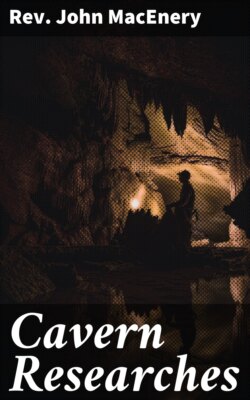Читать книгу Cavern Researches - Rev. John MacEnery - Страница 3
На сайте Литреса книга снята с продажи.
PREFACE.
ОглавлениеTable of Contents
The following Memoir is compiled from the original manuscript notes of the late Rev. J. MacEnery, for many years Chaplain at Tor Abbey, by whom the cavern was first explored. From the Prospectus it appears, that, when completed, it was to have been illustrated with thirty plates, by Scharf, representing the fossil remains of the natural size, with sections and ground plans of the principal caverns, “the limited circulation of works of this nature, however, being by no means equal to the expenses attendant upon the execution of so large a series,” the Author, after a second appeal was compelled to abandon his design. At his death the vast and invaluable collection of fossil remains was sold by auction, and, unhappily, dispersed; the manuscript was purchased in a lot of sermon notes and other papers by the late Mr. Lear, of Lawrence Place. It was for many years overlooked and supposed to be altogether lost to science. This circumstance and the value attached to Mr. MacEnery’s labours are thus referred to by Professor Owen, the highest authority on these subjects, in his History of British Fossil Mammalia:—“Perhaps the richest cave-depository of bears hitherto found in England is that called Kent’s Hole, near Torquay. It is to the assiduous researches of the Rev. Mr. MacEnery that the discovery of the various and interesting fossils of this cave is principally due, and some of the rarest and most valuable of this gentleman’s collection have been recently acquired by the British Museum. * * Mr. De Blainville frequently cites a ‘Description of the Cavern of Kent’s Hole, Devonshire,’ which he supposes to have been published by Mr. MacEnery, but which he regrets that he had not been able to procure.” I have been assured by Dr. Buckland that Mr. MacEnery never published such a work, but it is most probable that the drawings or lithographic impressions shewn by Mr. MacEnery to Professor De Blainville were those designed to illustrate the forthcoming second volume of the Reliquiæ Diluvianæ. Having accidentally discovered that the greater portion of the Memoir was in the possession of Mr. Lear, I published some extracts in the “Torquay Directory” with reports of Lectures which I delivered before the Natural History Society. It was subsequently purchased, with Mr. Lear’s cabinet of fossils, by W. Long, Esq., F.G.S., who most liberally presented it to me with a view to its publication. The manuscript is in a very imperfect state, consisting of fragments of the original notes, a portion being re-written several times with considerable alterations. In order to preserve the freshness of first impressions, and the exact statement of Mr. MacEnery’s views I give it, as far as possible, verbatim, scrupulously making no addition, and only omitting those passages which are in duplicate or irrecoverably mutilated, and re-adjusting the whole, as far as practicable, in a connected series. The notes upon Berry Head Cavern, referred to in the title page, are entirely lost. It was explored by the late Rev. F. Lyte in conjunction with Mr. MacEnery, and afforded similar results with the other caverns; also some human remains, supposed to be those of the Roman garrison.
Of the plates above referred to, sixteen were executed at the expense of the late lamented Dean of Westminster, and by the liberality of his son, F. Buckland, Esq. (2nd Life Guards), I have been permitted to have some proof impressions taken, to illustrate large paper copies.
The profits of this edition will be placed at the disposal of the Torquay Natural History Society, who, by permission of the proprietor, Sir L. V. Palk, Bart., propose to resume their explorations of Kent’s Cavern. I take this opportunity of stating that as this will be effected by a special fund, donations will be very acceptable. The researches in the newly-discovered cavern at Brixham, by a grant from the Royal Society, cause the subject to be now more than ordinarily interesting, and a careful comparison of the results obtained from each, will, it is hoped, throw much light upon this most interesting page of Geology and earliest human antiquities.
E. VIVIAN.
Woodfield, Torquay,
1st Jan. 1859.
